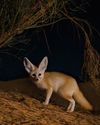Cracking The Mystery
BBC Wildlife
|March 2021
Why is the guillemot egg so shaped? ‘To stop it rolling away’ is the textbook answer. But is it correct? Follow one man's mission to get to the bottom of an evolutionary mystery.

The unusually shaped eggs of the common guillemot are large, colourful and very nutritious. Three times the size of a hen’s egg, guillemot eggs were, for centuries, eagerly sought by those with access to their colonies. In some areas, it was thought that at the sight of approaching human egg-collectors (known as ‘eggers’), guillemots deliberately threw their eggs off the breeding ledges rather than allow them to be taken.
Nonsense, of course, but it was an explanation for the shower of eggs that invariably rained down from the guillemot’s breeding cliffs whenever humans disturbed them. Tourist steamers often blasted their horn or fired a shotgun at guillemot colonies, so their passengers could enjoy the spectacle of guillemots pouring off the cliffs, causing their eggs to roll off and smash onto the rocks below.

Observations like these seem to contradict the idea that their unusual shape – described as pyriform or pear-shaped, with one very pointed end – has evolved to prevent the guillemot’s egg from rolling off a cliff ledge, where it is incubated on bare rock.
Guillemot eggs were a prime target for eggers, not just because of their size, but because they could be collected in huge numbers from the typically very dense, very large colonies. Centuries after people began collecting and eating guillemot eggs, the question arose as to why they were an unusual shape, compared to those of most other birds.
Denne historien er fra March 2021-utgaven av BBC Wildlife.
Abonner på Magzter GOLD for å få tilgang til tusenvis av kuraterte premiumhistorier og over 9000 magasiner og aviser.
Allerede abonnent? Logg på
FLERE HISTORIER FRA BBC Wildlife

BBC Wildlife
"I was terrified the elephant would ram us"
African elephant in Kenya
2 mins
January 2026

BBC Wildlife
ALL YOU EVER NEEDED TO KNOW ABOUT THE Fennec fox
THE FENNEC FOX IS THE SMALLEST fox in the world, with a body length that can be as little as 24cm.
3 mins
January 2026

BBC Wildlife
INTO THE PLASTISPHERE
A unique synthetic ecosystem is evolving in our oceans – welcome to the plastisphere
7 mins
January 2026

BBC Wildlife
“More than half of all animal life exists in a parasitic relationship, and all life lives in symbiosis”
Our survival depends on species evolving to live together - but some relationships take dark turns
7 mins
January 2026

BBC Wildlife
Are animals able to dream?
SLEEP IS A MYSTERIOUS THING. FOR A long time, we weren't sure why we do it.
1 mins
January 2026

BBC Wildlife
Does a cuckoo know it's a cuckoo?
ABSURD LITTLE BIRDS ACROSS THE world lay their eggs in the nests of other species, leaving the hapless parents to raise a changeling at the expense of their own offspring.
2 mins
January 2026

BBC Wildlife
Orcas killing young sharks
Juvenile great whites are easy prey for orca pod
1 mins
January 2026

BBC Wildlife
Ocean goes on tour
Acclaimed film touring the UK, backed by live orchestra and choir
1 min
January 2026

BBC Wildlife
Feisty bats hunt like lions
Winged mammals use a 'hang and wait' strategy to take down large prey
1 mins
January 2026

BBC Wildlife
SNAP-CHAT
Richard Birchett on magical merlins, wily coyotes and charging deer
2 mins
January 2026
Translate
Change font size

